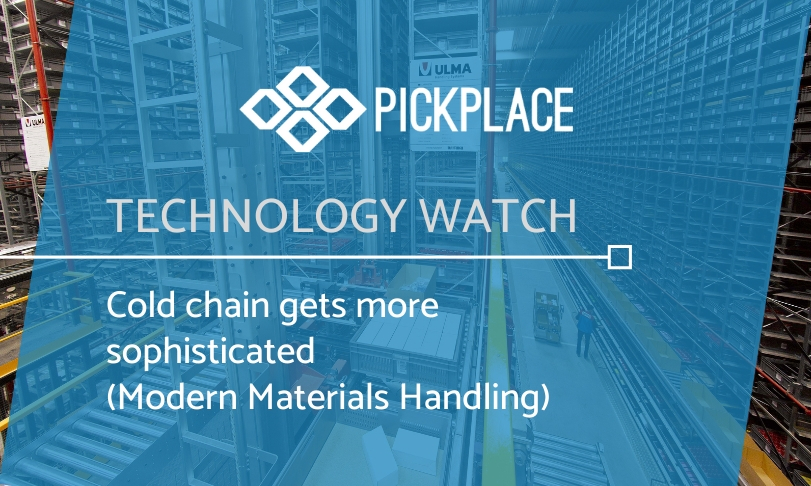Source: Modern Materials Handling / by Gary Forger

Cold chain is heating up. No, freezer and refrigerated warehouses aren’t getting any warmer. But, there sure is steadily increasing demand for their inhospitable temperatures. And, it’s true for food as well as pharmaceuticals.
“The cold storage sector and broader food industry continue to evolve nationally due to a variety of factors including changing consumer dietary and delivery preferences and growth in the frozen food sector,” says Lucy Curbin, vice president at the Food Facilities Group of real estate firm CBRE.
Factors here include groceries ordered online, including meal kits. The Food Marketing Institute expects this segment to grow from just $19 billion today to $100 billion by 2022. That, says CBRE, will cause 100 million additional square feet of cold storage space to be built.
On the pharma side, cold chain drugs will grow 59% from 2017 to 2023, says the industry publication Pharmaceutical Commerce. That, too, is resulting in new cold storage capacity. In addition, Amazon’s purchase of PillPack should contribute to growth here.
There’s also the matter of regulations for tracking food and pharma across the supply chain. The FDA’s Food Safety Modernization Act (FSMA) is focused on preventing food safety problems across the board. Meanwhile, the Drug Supply Chain Security Act (DSCSA) is intended to do much the same in pharma. In both cases, cold chain is very much a part of the consumer safety picture.
So, that combination of growth, regulations and consumer safety is having an impact on cold chain. Ask any expert for the leading trend and the word is automation. At the same time, regulatory requirements to track and document the cold in cold chain is resulting in new data networks inside and outside the four walls of the refrigerated or freezer warehouse.
The value of automation
If you think conventional warehouses have trouble finding people in the current labor market, at least double that degree of difficulty for refrigerated and freezer warehouses. After all, who wants to work at -20°F all day? Even if the breaks are frequent.
“Furthermore, the younger generation is even less inclined to work cold chain,” explains Tom Steininger, Dematic’s market development director for food and beverage. Clearly, automation is the way to go if possible. But, it can be challenging.
“The capital outlay is so significant that the adjustment to the initial investment is huge. Furthermore, the move to automation also fundamentally changes day-to-day operations. That said, the payoffs are substantial,” Steininger says.

Despite strong gains lately in automation, people are still part of the cold chain equation.
Beyond the labor savings, automation allows more compact facilities, saving on very expensive refrigeration costs. Steininger says a greenfield automated storage and retrieval system (AS/RS) saves up to 80% in labor, 40% to 60% in space, and 30% to 40% in energy requirements.
Preferred Freezer Services recently opened a 380,000-square-foot freezer warehouse (which Modern featured as a System Report in February 2018) that is said to be the largest automated freezer warehouse in North America. It has three freezers that hold up to 200 million pounds of French fries at a time serviced by an AS/RS (Dematic). An overhead monorail delivers and takes away pallets.
Dematic CEO John Galiher says, “My customers are concerned about the rising cost and availability of labor. They’re worried about regulation, and, more importantly, they want data to prove that our system is delivering what we say it’s delivering.” Automation delivers on all of those as it reduces damage and provides an accurate, real-time tracking of product, he adds.
Mike Pitt, director of AS/RS engineering at Daifuku Wynright, talks about a Blue Bell Creameries freezer for its 250 different frozen desserts. The facility has more than 7,700 pallet positions in an 89-foot-tall AS/RS. The new system’s building is next door to a 50-foot tall freezer facility with a man-ride storage and retrieval system.
Pitt explains that the reduction of labor as well as the increased timing and reliability possible are critical to overall efficiency. In fact, the number of pallet moves in the facility were greatly reduced with the AS/RS.
Cold chain beyond automation
Not all freezer or refrigerated operations can entirely do without people, especially as e-commerce becomes a bigger factor.
“Let’s face it,” says Bryan Jensen, chairman and executive vice president of St. Onge Co., “e-commerce has a higher labor content than most other operations and much of that is in eaches.” As Steininger of Dematic points out, case picking is growing as grocery stores and others don’t need full pallet loads of product in many instances. And that often requires people in the facility.

Blue Bell Creameries has automated freezer handling wherever possible.
“In addition, cold chain products are getting swept along with all the other shifts in consumer buying,” explains Keith Goldsmith, senior vice president food and beverage for MonarchFx.
That is having an impact on product flow in the cold chain facility. No place is that more noticeable, says Goldsmith, than among small, challenger food brands often as private labels. “Consumers are being drawn to new brands and healthier ones. And at this point, those brands are being managed as cases rather than pallets,” he adds.
There’s also the matter of direct-to-consumer sales. “They are growing rapidly,” says Goldsmith. He includes grocery store foods handled manually by companies such as Amazon Fresh and Peapod along with meal kits from companies such as Blue Apron.
Lift truck companies in particular are not missing this opportunity. Suppliers such as UniCarriers Americas, Yale, Hyster, Raymond and Crown have all recently introduced trucks for use in cold storage and freezer environments. In some cases, heaters are part of the truck as are special fluids and lubricants for temperatures as low as -40°F. Models range from counterbalanced and high-reach trucks to rider pallet trucks.
Raymond is also focusing on lithium ion batteries for cold chain applications, says Christine Edwards, energy solutions manager. While initially twice as expensive as lead acid batteries, lithium ion has a total cost of ownership over two to three years that is 25% less, she explains. Over a full shift, Edwards says lithium ion has higher performance than lead acid, especially in the final 20% of the charge. That’s when lift and travel speeds with lead acid tend to trail off.
As, Chris Merta, Raymond’s manager of automation applications, points out, there are few automated lift trucks in the cold chain today. The problem is condensation on sensors used to navigate. However, he “expects that limitation to be solved soon and to see a plethora of automated trucks in cold storage in the next couple of years.”
Building data networks
With the FSMA and DSCSA, data networks to automatically track cold chain food and pharma products are on the rise inside and outside the four walls.
“We are at a bit of an inflection point with deadlines in the regulations,” says Steve Simmerman, senior director of sales/global partners and alliances at JDA.
And this is no small undertaking, explains Bruce Stubbs, Honeywell’s customer success manager for global corporate strategic accounts. He says a Honeywell survey in 2017 showed that 27% of pharma tracking was on paper. As of last year, that number had dropped to less than 10% with DSCSA deadlines looming.
“Whether it is food or pharma, the objective is to have greater visibility into the location and condition of the product to ensure consumer safety,” Stubbs adds.

Paper tracking of food in the food and pharma cold chains is giving way rapidly to electronic means.
One of the first places that companies are turning to are warehouse management systems (WMS).
Modern recently (June 2019) published a System Report about how Nassau Provisions Kosher Foods turned to a WMS (HighJump) to ensure accurate inventory in the right location and more timely deliveries. The software also automatically captures catch weights and expiration dates by scanning serial numbers, eliminating hand-written notes.
While Nassau has been around for 40 years, Good Eggs is an online grocery delivery service including produce and meal kits. About 40% of its San Francisco area warehouse is temperature controlled, both refrigerator and freezer.
Good Eggs also recently installed a WMS (HighJump), explains Craig Moore, vice president of sales at the WMS provider. It also scans bar codes to ensure putaway in proper zones, track inventory against expiration dates and reduce spoilage, Moore says. And with a tag line of “Absurdly Fresh,” Good Eggs can’t afford to deliver produce any less, adds Moore.
Meanwhile, DMLogic has developed track-and-trace software specifically for pharmaceuticals. Known as STEPLogic Trace, the software is fully integrated with a leading WMS, and provides full compliance with DSCSA, says Matt Deep, DMLogic vice president. “The software tracks and traces pharma by serial number both within the four walls and from supply chain node to node. It also ensures all key data are stored in a single location, the WMS,” Deep adds.
Looking forward, Deep says we are in the early stages of building these data networks. He expects the technology to become more robust over the near term. That, he says, will allow the data to be part of not just the supplier’s network but shared with customers, too, creating a much higher level of visibility in the pharma cold chain by 2025.
There’s also the matter of the cold chain between nodes. For instance, Honeywell offers its Connected Freight solution that allows shippers and logistics companies to monitor goods between nodes. It provides information about inventory in transit, and that’s the intent of many emerging solutions.
For instance, Tive offers active tags that monitor the temperature every few minutes during transit. As CEO Krenar Komoni explains, the tags give real-time visibility into the location and temperature of the shipment while helping companies analyze those variations over time.
Softbox has been working with leading pharmaceutical and telecommunications organizations to enable cold chain visibility of drone delivery medical supplies. As Richard Wood, director of connected digital technologies at Softbox, explains, the Softbox insulated drone payload container uses IoT (Internet of Things) technologies. Temperature data is sent by wireless signal from within the cold chain compartment to an IoT gateway, which then transmits the shipment data to a secure, Internet dashboard portal. The drone flights can last up to 30 minutes and cover in excess of 60 miles, with temperature, locations and security data being collected every 30 seconds.
Similarly, ShipChain is building a platform for temperature-sensitive shipments that tracks temperature and location, says John Monarch, CEO. Temperature-enabled smart tags collect the data, which is sent to the ShipChain blockchain to ensure secure and seamless authentication and chain of custody for pharma and food products, adds Monarch. In addition, a highly scalable blockchain visibility platform secures data as it tracks and monitors shipments.
Clearly, cold chain is receiving quite a bit of attention from many different quarters these days. And with consumer safety high on the list of priorities for the industry, expect to see more in the near future.

